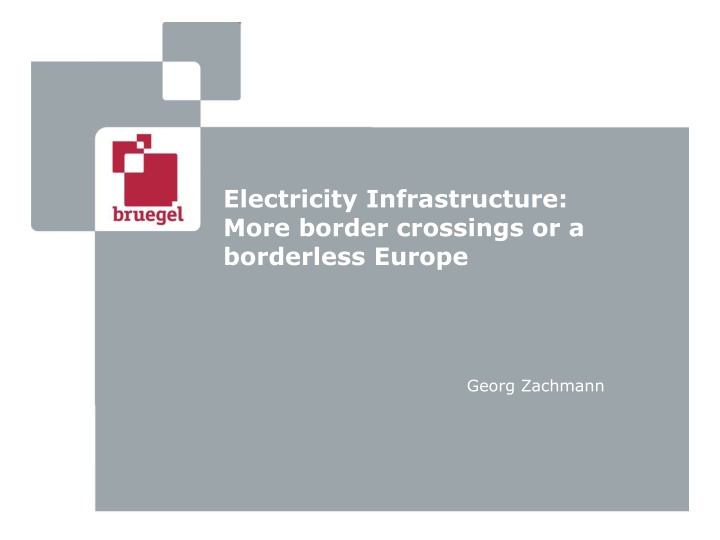
Electricity Infrastructure Challenges in Europe: A Comprehensive Analysis
Exploring the complexities of electricity infrastructure in Europe, this analysis delves into factors such as border crossings, regulatory uncertainties, stakeholder interests, and funding structures. The discussion highlights the need for innovative proposals to address the current shortcomings in market rules and investment frameworks.
Download Presentation

Please find below an Image/Link to download the presentation.
The content on the website is provided AS IS for your information and personal use only. It may not be sold, licensed, or shared on other websites without obtaining consent from the author. If you encounter any issues during the download, it is possible that the publisher has removed the file from their server.
You are allowed to download the files provided on this website for personal or commercial use, subject to the condition that they are used lawfully. All files are the property of their respective owners.
The content on the website is provided AS IS for your information and personal use only. It may not be sold, licensed, or shared on other websites without obtaining consent from the author.
E N D
Presentation Transcript
Electricity Infrastructure: More border crossings or a borderless Europe Georg Zachmann
Agenda 1. The current context: many complicating factors 2. Insufficiency of the current approach 3. Proposal 4. Discussion 2
The 'system nature' of the electricity sector Individual decisions have an impact on all other actors Very different solutions for the same problem chicken-and-egg problems 3
Uncertainty Volatile regulatory environment In the past two decades: liberalisation, unbundling, cross-border trading renewables support, emissions trading, nuclear phase-out And in the future European integration Electrification vs. energy efficiency vs. long asset lifetimes 4
Different interests: stakeholders Everybody wants a different transmission network: Consumer (connect to low and stable prices) Producer (connect to high prices) Storage (connect to volatile prices) TSOs (domestic copperplate controllable international) Regulators (domestic benefit) Residents (NIMBY) 5
Different interest: countries Exporting countries Transit countries Importing countries 6
Complex funding structures 'regulated asset base' International spillovers require cost-benefit analysis and corresponding redistribution scheme Not yet present => Academically challenging and politically complex Merchant lines Public money 7
Agenda 1. The current context: many complicating factors 2. Insufficiency of the current approach 3. Proposal 4. Discussion 8
Insufficiencies of Market rules 1. Congestion within countries will be dealt with differently from network congestion between countries 2. Network codes are unlikely to bring about workable interfaces at all borders for all dimensions of electricity trade 3. National markets/regulations will remain pivotal for investment 9
Transmission investment in Germany in Mio Building the network Planning a non-binding proposal by ENTSO-E to the individual TSOs. stakeholder not legally accountable Source: Bundesnetzagetur (2012) non-transparent Funding 2012 status of 2010 TYNDP projects Merchant: underbuilds as planned CEF: only ~5 bn and politically selected projects delays in the authorisation RAB: lack of int l CBA generators re- scheduled their plans
Proposal 1. The current context: many complicating factors 2. Insufficiency of the current approach 3. Proposal 4. Discussion 11
Add a European system management layer European control centre (See flight control ) Internalise redistribution Nodal pricing Day-to-day responsibility with national fall-back 12
Establish a stringent planning process Upgrade the TYNDP: national regulators can only approve projects proposed by European planning Make the TYNDP welfare-maximising: ACER should be requested and enabled to thoroughly check that the TYNDP maximises the welfare of current and future European citizens. Build an European open-source reference energy infrastructure model Structure a process in which all relevant stakeholders can contribute to the assumptions and the modelling Make stakeholders liable to claims for damages from other stakeholders if they deviate from their predictions Democratically legitimise the TYNDP : to reach conclusion on distributional consequences 13
Phase in European cost-benefit sharing Deep connection charges Harmonized grid tariff structure (distribution between network users) An approximate beneficiary pays component A socialization component 14
Conclusion 1. The current context: many complicating factors 2. Insufficiency of the current approach 3. Proposal 4. Discussion 15
Cooperation on a line-by-line basis vs. institutionalized cooperation ? Pro institutionalization: Efficiency gain of a European picture Consistent target market design reduces uncertainty Infrastructure planning as an anchor for coordination Avoid triggering down of national infrastructure plans on the power system Contra institutionalization : - Is a stable consensus feasible? - Transaction cost of institutionalization? 16
